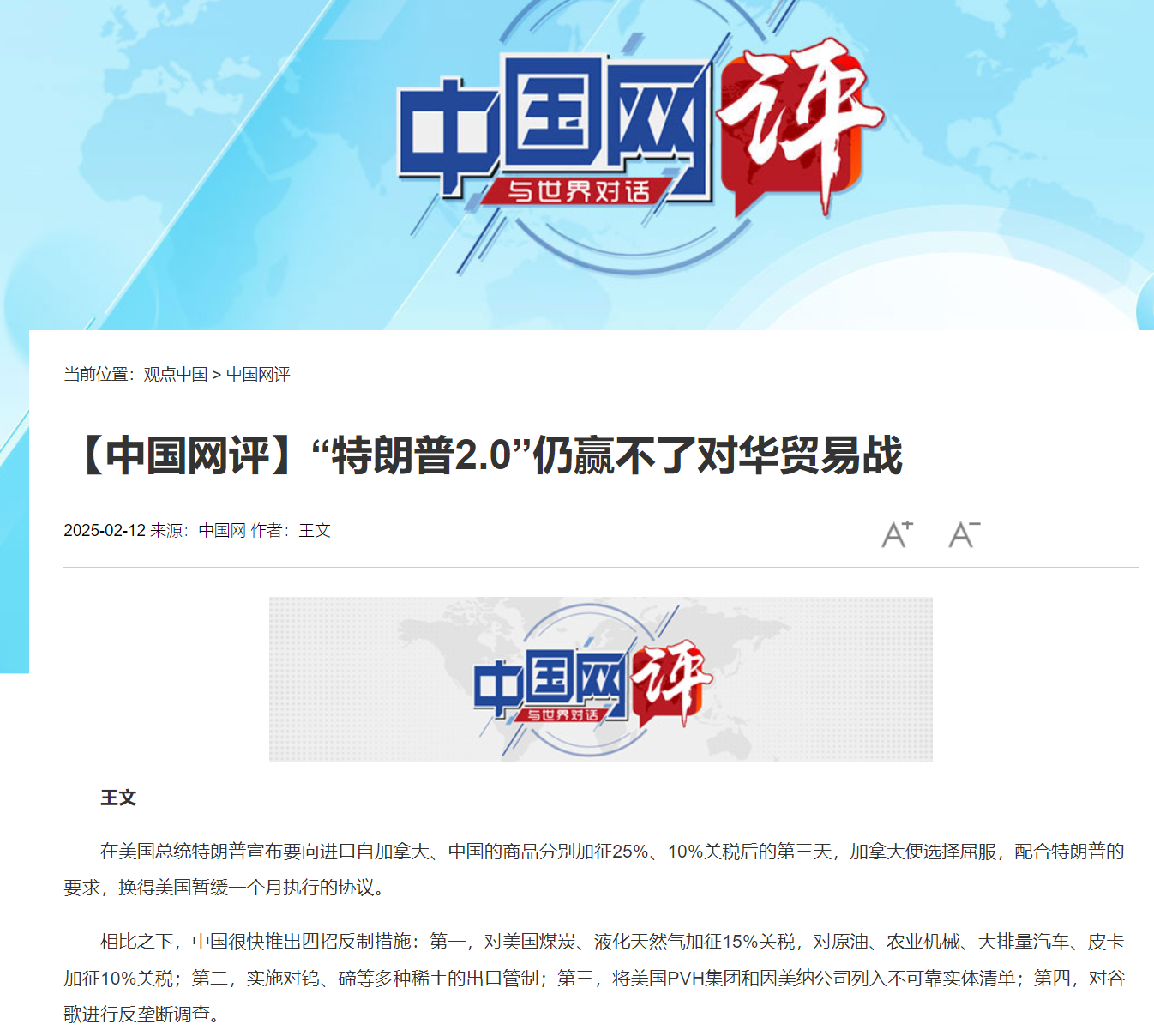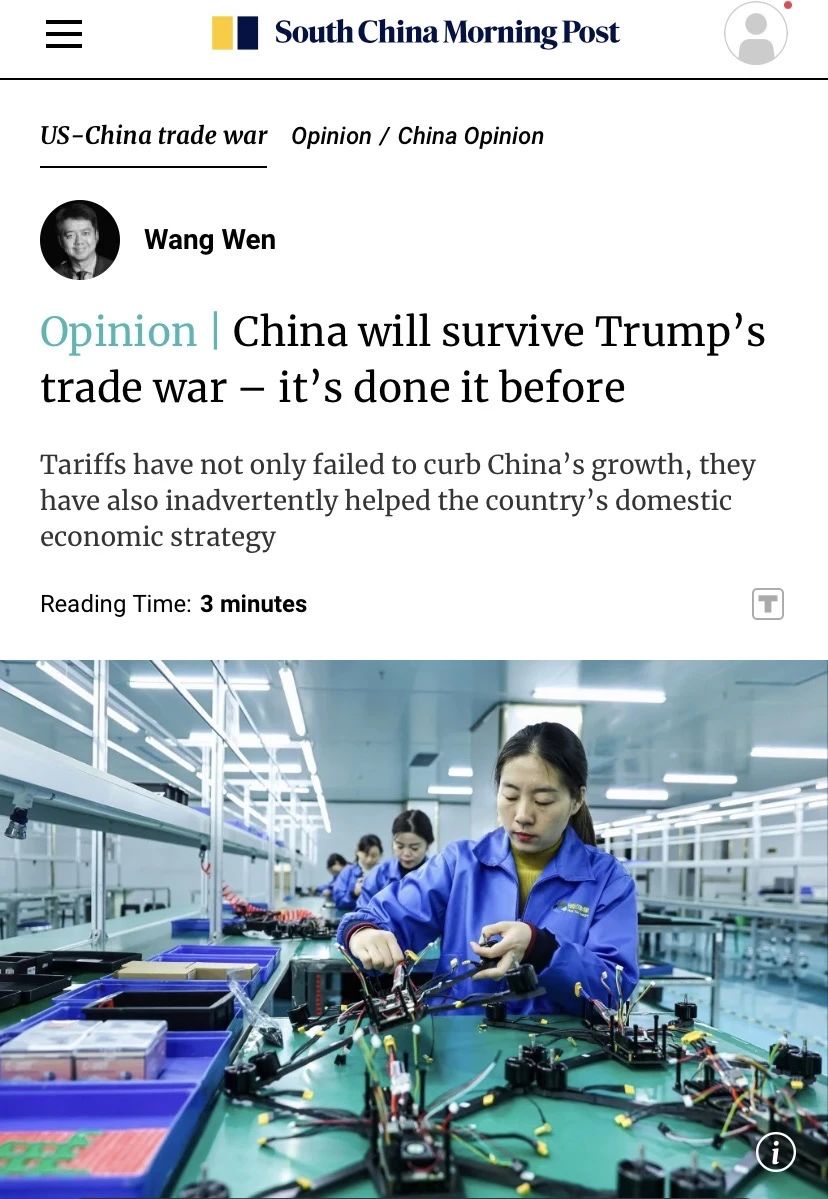发布时间:2025-02-17 作者: 王文
2025年2月8日-16日,中国人民大学重阳金融研究院院长、中美人文交流研究中心(教育部)执行主任王文撰文《为什么特朗普2.0对华贸易战必将失败》一文,不同版本在 美国《国际政策文摘》 、 马来西亚《新海峡时报》 、 澳大利亚《珍珠与刺激》(7个语种) 、俄罗斯瓦尔代俱乐部官网,中国香港 《南华早报》 , 中国网 等刊发,引发国际舆论高度关注。
编者按:2025年2月8日-16日,中国人民大学重阳金融研究院院长、中美人文交流研究中心(教育部)执行主任王文撰文《为什么特朗普2.0对华贸易战必将失败》一文,不同版本在 美国《国际政策文摘》 、 马来西亚《新海峡时报》 、 澳大利亚《珍珠与刺激》(7个语种) 、俄罗斯瓦尔代俱乐部官网,中国香港 《南华早报》 , 中国网 等刊发,引发国际舆论高度关注。现将中、英版本发布如下:
美国
2月8日,美国《国际政策文摘》刊发该文。

当特朗普宣布要向进口加拿大、中国商品分别加征25%、10%关税后的第三天,加拿大就屈服,配合特朗普的要求,换得美国暂缓一个月执行的协议。
但中国很快推出四招反制措施:第一,对美国煤炭、液化天然气加征15%关税,对原油、农业机械、大排量汽车、皮卡加征10%关税;第二,实施对钨、碲等多种稀土的出口管制;第三,将美国PVH集团和因美纳公司列入不可靠实体清单;第四,对谷歌进行反垄断调查。
很明显,中国没有像加拿大那样投降,而是推出更严厉、更精准、更多样的反制措施。根本原因是,经过8年的贸易战,中国变得更自信、更聪明、有坚韧。
自2018年特朗普1.0向中国发动贸易战以来,中国对美出口商品长期保持着19%左右的关税,中国人已经习惯了贸易战,再加10%似乎并不是什么大事。
从八年的贸易战效果看,特朗普1.0想要达到的目标明显落空了。相较于2018年,2024年中国贸易总额增长了44%,中美贸易总额增长了8%,中国对美顺差总额也增长了13%。贸易战非但没有让中美贸易脱钩,反而让中国的顺差额更大了。
马来西亚
2月9日,马来西亚《新海峡时报》及其官方Facebook和X推特刊发该文。

另一个有趣的数据是,中美贸易额占中国贸易总额的比例从2018年的14%下降到了2024年的11%。美国对中国的重要性在下降。
更重要的是,美国对中国的科技禁运,推动中国的科技自主创新。2024年中国芯片自主率已达到30%,是2018年的一倍。华为公司的芯片自主率更是达到了100%。华为营业额已回升,并超过2018年。此外,中国还涌现了更多新的高科技公司,比如Tiktok、Deepseek等等。
特朗普1.0没有打败中国。八年后的中国更强大,特朗普2.0时代更不可能打败中国。特朗普的关税恐吓,只能吓倒加拿大、墨西哥,或者还有欧洲,但不可能吓倒已有八年成功经验的中国。
澳大利亚
2月11日,澳大利亚《珍珠与刺激》官网7语种刊发该文,并在其官方Facebook和X推特转发报道。

中国的底气源于强大的制造业。中国制造业总体规模连续15年保持世界第一。2024年中国制造业份额占据了世界31.6%,约是美国(15.9%)的二倍和日本(6.5%)的五倍。中国制造占世界超过50%的产业包括钢铁、水泥、纺织品、化纤、个人电脑、手机、汽车、冰箱、空调、洗衣机、液晶面板、电视、微波炉、风电装机量、5G基站、高铁、消费级无人机、工业级无人机、发电量、医疗原料药等等。
中国对美出口的主要产品包括机电、家具玩具、塑料制品、纺织品等,都是中国极具领先竞争力的工业领域,也是直接影响美国民众日常生活的消费领域,比如,美国手机70%都是中国制造。美国爆款玩具95%都从中国进口。
当特朗普加征的关税转移到中国出口商与美国进口商之间的博弈时,中国出口商一定具有更多议价权,迫使美国进口商来支付额外的关税费用,最终后者则会将关税成本转嫁为美国国内消费品的涨价。
更糟糕的是,看看2024年美国出口的结构就会惊然发现,美国已越来越往资源出口国的方向退化。2024年,美国出口金额的前三大商品分别是成品油(出口额1336亿美元)、原油(1150亿美元)、天然气(950亿美元),三项占有美国出口总额(1.44万亿美元)的1/4。美国出口总额仅有中国(3.6万亿美元)的40%。
相比之下,人们印象中的美国出口强项汽车(570亿美元)、集成电路/芯片(508亿美元)仅仅排在第四、五位。这两项出口金额都不及中国同类产品出口金额的一半。2024年中国汽车出口额达到1174 亿美元,集成电路/芯片出口额则为1595亿美元。这正是中国出口强大竞争力的集中表现,也是美国制造业衰落的典型折射。
中国网
2月12日,中国网刊发该文。

从这个角度看,特朗普从1.0时代就开始的关税政策,表面上看是希望能拯救美国制造业,换来的只是美国制造业日益衰退以及物价的持续上涨。特朗普根本上只是为了向美国选民显示他对中国很强硬。这无疑是一种政治骗术。
特朗普2.0没有从国内根子上去寻找制造业衰落的原因,反而借关税往国外去寻找替罪羊,这明显是在政治操弄和欺骗,最终惩罚的是美国人自己。
很明显,1/4出口靠卖资源的美国,并没有足够的出口竞争力。一旦世界看透了特朗普2.0的虚张声势,比如加拿大、墨西哥、中国还有欧盟都联合起来对付美国,共同提升对美国产品的关税,美国能源出口定会受损,而美国国内产品也会因关税再次导致严重的通货膨胀,甚至美国的经济将会崩溃。
由此看,特朗普不会让美国再伟大,只会让美国继续衰落。特朗普2.0关税政策,再次折射了美国已不再是世界的领导国家,而是一个普通的区域国家,一个制造双边冲突、全球失序的麻烦制造者的国家。
《南华早报》
2月16日,中国香港《南华早报》刊发该文。

英文版
Why Trump 2.0’s trade war with China
is doomed to fail
Three days after President Trump announced a 25 percent tariff on Canadian goods and a 10 percent tariff on Chinese goods, Canada acquiesced to Trump’s demands in exchange for a one-month suspension of the tariffs.
China responded with four countermeasures: First, it imposed a 15 percent tariff on US coal and liquefied natural gas and a 10 percent tariff on crude oil, agricultural machinery, large-displacement vehicles and pickup trucks. Second, Beijing implemented export controls on rare earth elements such as tungsten and tellurium. Third, China included PVH Group and Innolux on its unreliable entities list. Fourth, Beijing launched an antitrust investigation into Google.
Unlike Canada, China did not back down. Instead Beijing introduced tougher, more precise and diversified countermeasures. The fundamental reason is that after nearly eight years of trade conflict, China has grown more confident, strategic and resilient.
Since Trump 1.0 launched a trade war against China in 2018, Chinese exports to the US have consistently faced tariffs of about 19 percent. By now the Chinese public is well accustomed to trade disputes and an extra 10 percent tariff hardly comes as a shock.
Looking at the long-term impact, the objectives Trump set out to achieve in 2018 have largely gone unmet.
Compared with 2018, China’s total trade volume grew by 44 percent in 2024, trade between China and the US increased by 8 percent and China’s trade surplus with the US expanded by 13 percent. Rather than decoupling the two economies, the trade war has widened China’s trade advantage.
Another key metric is the share of US-China trade in China’s total trade, which has dropped from 14 percent in 2018 to 11 percent in 2024. This decline underscores the decreasing importance of the US market to China.
Not only have tariffs failed to curb China’s growth, they have also inadvertently strengthened China’s internal strategies, particularly in manufacturing and technology. US technology restrictions, for instance, have accelerated China’s push for technological self-sufficiency.
By 2024, China’s share of domestically produced chips used in its technology sector reached 30 percent, double the 2018 level, while Huawei achieved full self-sufficiency in chip production. Huawei’s revenue has rebounded to surpass 2018 levels and new Chinese tech giants such as TikTok and DeepSeek have emerged.
The first Trump administration failed to defeat China, and after eight years, the country has only grown stronger. The second Trump administration looks even less likely to succeed. While Trump’s tariff threats may intimidate Canada, Mexico or Europe, they hold little sway over China, which now has nearly a decade of experience countering such policies.
China’s confidence stems from its formidable manufacturing sector, which has been the world’s largest for 15 consecutive years.
In 2024, China accounted for 31.6 percent of global manufacturing output, roughly double that of the US (15.9 percent) and five times that of Japan (6.5 percent). Chinese manufacturers dominate industries with over 50% of the world's market share, including but not limited to steel, cement, textiles, personal electronics, household appliances, 5G base stations, high-speed trains, and consumer drones.
China’s primary exports to the US include electrical machinery, furniture, toys, plastics and textiles: industries that are highly competitive and integral to American consumers’ daily lives.
For instance, 70 percent of mobile phones in the US are made in China and 95 percent of the country’s top-selling toys are imported from China.
Tariffs on these goods will ultimately raise prices for American consumers as the costs are passed down the supply chain.
Even more concerning is the composition of US exports in 2024. The country has increasingly shifted toward resource exports. Refined petroleum ($133.6 billion), crude oil ($115 billion) and natural gas ($95 billion) were the top three US exports, collectively accounting for a quarter of total US exports ($1.44 trillion).
In contrast, the US exported just $57 billion in automobiles and $50.8 billion in integrated circuits, both of which are less than half of China’s export figures for the same products: By 2024, China’s automobile exports reached $117.4 billion, while its chip exports totaled $159.5 billion. These figures highlight China’s growing export competitiveness and the relative decline of US manufacturing.
It should be obvious that the US, which relies on selling natural resources for a quarter of its exports, does not have sufficient export competitiveness.
Trump’s tariffs since 2018 were presented as a strategy to revive US manufacturing. In reality, they have weakened it, driven up consumer prices and failed to achieve their goals. The president is talented at positioning himself as tough on China for electoral gain, but this is little more than political posturing.
Rather than addressing the root causes of US manufacturing decline, Trump 2.0 is using tariffs as a political tool, scapegoating foreign competitors while ultimately harming American consumers and businesses.
If countries such as Canada, Mexico, China and the European Union retaliate with their own tariffs on US goods, America’s resource exports will suffer, inflation will rise and the US economy could face severe consequences.
His tariff strategy reflects a shift in the US from a global leader to a regional power embroiled in trade conflicts and economic instability. From this perspective, Trump’s policies are most certainly not making America great again. In fact, they are accelerating its decline.
(欢迎关注人大重阳新浪微博:@人大重阳 ;微信公众号:rdcy2013)